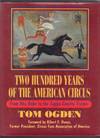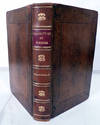
Morgante maggiore....: Nuovamente stampato & con ogni diligenza corretto. A cui e` aggiunta una bellissima tavola con la dichiaratione di tutti i vocaboli oscuri, che nell'opera si contengono.
by Pulci, Luigi
- Used
- Very Good
- Condition
- Very Good
- Seller
-
Tuxedo Park, New York, United States
Payment Methods Accepted
About This Item
Venice: Comin da Trino di Monferrato, 1550. Very Good. Quarto (22 cm); [16], 197 leaves, lacking final blank. Woodcut portrait in profile, ostensibly of the author crowned with laurel (but bearing little resemblance to the weak-chinned profile of Pulci in Fra Lippo Lippi's fresco in the church of Santa Maria del Carmine in Florence--in fact, the printer seems to have borrowed the wood block from his cousin Gabriele Giolito, who used it in his edition of Boccaccio in 1542); the portrait within a border populated by frolicking putti. Woodcut vignettes and tall woodcut initials open each of the 28 cantos of the poem. In elegant 19th-century green morocco by Thompson, ruled in gilt, with fleurons and central arabesque in gilt; all edges gilt (fore-edge gilt over marbling, so bending the fore-edge reveals the marbling); Spine in six gilt-framed compartments. Occasional very light foxing. Light wear to joints. Old ownership inscription on title page (Biblioteca grimbergensis). In effect, a fine copy!
References: Adams P-2255; Gamba 790n; EDIT16 69264; Fontanini, I,260 ("pieno di cose vili e plebee
Pulci, Luigi. Morgante maggiore. Nuovamente stampato & con ogni diligenza corretto. A cui e` aggiunta una bellissima tavola con la dichiaratione di tutti i vocaboli oscuri, che nell'opera si contengono. Venice: Comin de Trino di Monferrato, 1550. Quarto (22 cm); [16], 197 leaves, lacking final blank. Woodcut portrait in profile, ostensibly of the author crowned with laurel (but bearing little resemblance to the weak-chinned profile of Pulci in Fra Lippo Lippi's fresco in the church of Santa Maria del Carmine in Florence); the portrait within a border populated by frolicking putti. Woodcut vignettes and tall woodcut initials open each of the 28 cantos of the poem. In elegant 19th-century green morocco by Thompson, ruled in gilt, with fleurons and central arabesque in gilt; all edges gilt (fore-edge gilt over marbling, so bending the fore-edge reveals the marbling); Spine in six gilt-framed compartments. Occasional very light foxing. Light wear to joints. In effect, a fine copy!
References: Adams P-2255; Gamba 790n; Very Good.
Luigi Pulci caroused Florence with Lorenzo de' Medici in early days, when Lorenzo was writing "Quant'è bella giovinezza" ("It's great to be young; let the good times roll"). The two shared an understanding about the pleasure of being alive. It didn't last. Without rehearsing the whole drama, suffice it to say that Lorenzo became increasingly drawn into the mystical teachings of Marsilio Ficino, while Pulci became increasingly atheistic and secular.
Over a twenty year period, Pulci worked on the great chivalric epic offered here, a wandering narrative describing the confused itineraries of knights errant, their quests, battles, and loves, through kaleidoscopic plot lines characterized by thrilling versification and poetic originality. One 20th century critic wrote, "the language itself is the show" (De Robertis, 1966, "le parole finiscono col fare spettacolo da sole, " quoted in DBI).
This mid-century edition was published by Giolito's cousin (maybe) Comin da Trino di Monferrato. Comin was frequently in trouble with Venice's virtue police for printing heterodox texts, that is, Protestant-leaning authors such as Erasmus and Calvin. Nevertheless he enjoyed a long and fertile career, publishing many editions of Italian vernacular authors, alongside the obligatory prayer books and religious tracts. In a sense, the Morgante Maggiore is a happy pairing between author and printer, both considered troublemakers by the powers that be.
References: Adams P-2255; Gamba 790n; EDIT16 69264; Fontanini, I,260 ("pieno di cose vili e plebee
Pulci, Luigi. Morgante maggiore. Nuovamente stampato & con ogni diligenza corretto. A cui e` aggiunta una bellissima tavola con la dichiaratione di tutti i vocaboli oscuri, che nell'opera si contengono. Venice: Comin de Trino di Monferrato, 1550. Quarto (22 cm); [16], 197 leaves, lacking final blank. Woodcut portrait in profile, ostensibly of the author crowned with laurel (but bearing little resemblance to the weak-chinned profile of Pulci in Fra Lippo Lippi's fresco in the church of Santa Maria del Carmine in Florence); the portrait within a border populated by frolicking putti. Woodcut vignettes and tall woodcut initials open each of the 28 cantos of the poem. In elegant 19th-century green morocco by Thompson, ruled in gilt, with fleurons and central arabesque in gilt; all edges gilt (fore-edge gilt over marbling, so bending the fore-edge reveals the marbling); Spine in six gilt-framed compartments. Occasional very light foxing. Light wear to joints. In effect, a fine copy!
References: Adams P-2255; Gamba 790n; Very Good.
Luigi Pulci caroused Florence with Lorenzo de' Medici in early days, when Lorenzo was writing "Quant'è bella giovinezza" ("It's great to be young; let the good times roll"). The two shared an understanding about the pleasure of being alive. It didn't last. Without rehearsing the whole drama, suffice it to say that Lorenzo became increasingly drawn into the mystical teachings of Marsilio Ficino, while Pulci became increasingly atheistic and secular.
Over a twenty year period, Pulci worked on the great chivalric epic offered here, a wandering narrative describing the confused itineraries of knights errant, their quests, battles, and loves, through kaleidoscopic plot lines characterized by thrilling versification and poetic originality. One 20th century critic wrote, "the language itself is the show" (De Robertis, 1966, "le parole finiscono col fare spettacolo da sole, " quoted in DBI).
This mid-century edition was published by Giolito's cousin (maybe) Comin da Trino di Monferrato. Comin was frequently in trouble with Venice's virtue police for printing heterodox texts, that is, Protestant-leaning authors such as Erasmus and Calvin. Nevertheless he enjoyed a long and fertile career, publishing many editions of Italian vernacular authors, alongside the obligatory prayer books and religious tracts. In a sense, the Morgante Maggiore is a happy pairing between author and printer, both considered troublemakers by the powers that be.
Reviews
(Log in or Create an Account first!)
Details
- Bookseller
- Rodger Friedman Rare Book Studio
(US)
- Bookseller's Inventory #
- 6721
- Title
- Morgante maggiore....
- Author
- Pulci, Luigi
- Book Condition
- Used - Very Good
- Quantity Available
- 1
- Publisher
- Comin da Trino di Monferrato
- Place of Publication
- Venice
- Date Published
- 1550
- Weight
- 0.00 lbs
- Keywords
- Bookseller catalogs
- Renaissance and Early Modern Humanism;
Terms of Sale
Rodger Friedman Rare Book Studio
All items guaranteed authentic and as described. Any purchase is returnable for any reason within 10 days of receipt. New York State residents are obliged to add sales tax. Shipping charges will be assessed and billed at full value.
About the Seller
Rodger Friedman Rare Book Studio
Biblio member since 2006
Tuxedo Park, New York
About Rodger Friedman Rare Book Studio
Rodger Friedman Rare Book Studio owes its name and its inspiration to the traditional Italian studio bibliografico. These small antiquarian bookshops, typically run by individuals who combine deep scholarship with a love of the printed object, remind us that underlying the words "study" and "studio" is the Latin term for zeal and devotion, studium. Since 1993, my goal has been to match discerning collectors with extraordinary books and manuscripts.
Glossary
Some terminology that may be used in this description includes:
- Fine
- A book in fine condition exhibits no flaws. A fine condition book closely approaches As New condition, but may lack the...
- Spine
- The outer portion of a book which covers the actual binding. The spine usually faces outward when a book is placed on a shelf....
- Edges
- The collective of the top, fore and bottom edges of the text block of the book, being that part of the edges of the pages of a...
- Gilt
- The decorative application of gold or gold coloring to a portion of a book on the spine, edges of the text block, or an inlay in...
- Title Page
- A page at the front of a book which may contain the title of the book, any subtitles, the authors, contributors, editors, the...
- Quarto
- The term quarto is used to describe a page or book size. A printed sheet is made with four pages of text on each side, and the...
- Leaves
- Very generally, "leaves" refers to the pages of a book, as in the common phrase, "loose-leaf pages." A leaf is a single sheet...
- Morocco
- Morocco is a style of leather book binding that is usually made with goatskin, as it is durable and easy to dye. (see also...





